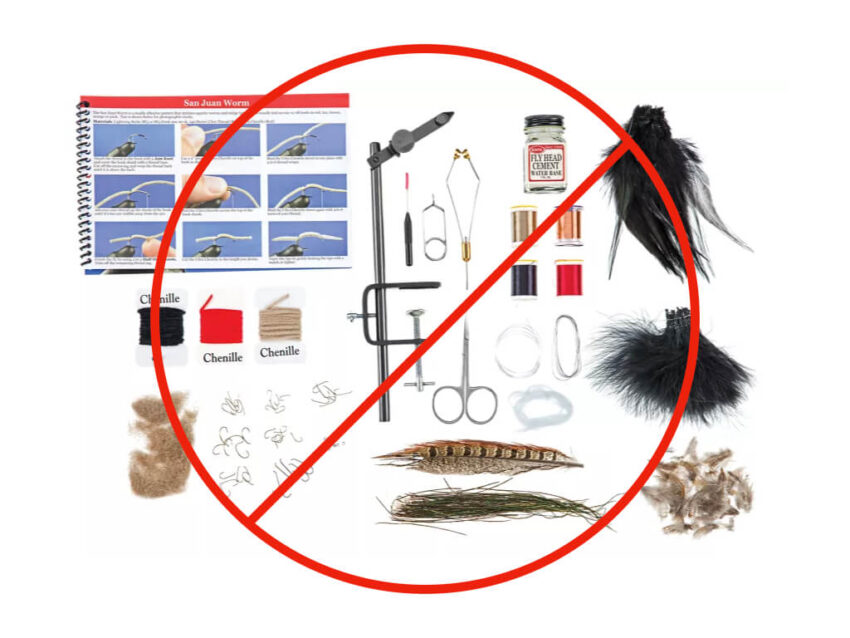
Fly Tying Tools – Getting Started the Right Way
Why listen to me? I started tying flies 35 years ago. I now tie flies professionally. Did I get started the right way? Not a chance. I bought a kit with a vise that would barely hold a hook and contained an incomplete set of very cheap and frustrating-to-use tools. I have replaced these several times over and added some additional tools as my tying has gotten more advanced, but I still have a handful of go-to tools I use on every fly. I will provide this short list of must-haves and also some specific tools for specific fly styles or tying techniques. The goal is to avoid my starting situation of coupling poor tools with lack of experience which resulted in unnecessary frustration and slow progress.
FULL DISCLOSURE: I have no business relationship with any of these manufacturers in any way. I am not a memeber of any affiliate program. I do make a few pennies from ads on the site. This does not influence my product recommendations as I do not control the ads that are displayed to you.
What is Wrong with a Fly Tying Tools Kit?

I will admit, some have gotten better (the one pictured above is not one of them). I will also say that I have not seen one that is complete. They all seem to have lots of useless things in them that are there to simply increase the volume of contents in the kit. Additional reasons to avoid kits:
- Poor Quality Vises – the vise is the foundation of your work. A good vise should hold the hook firmly and rotate as required. It doesn’t have to be the most expensive one on the market. I still tie on a Renzetti Traveler. Get a decent vise if you don’t take any other recommendations to follow.
- Quality – the tools provided usually vary greatly in quality. Unless produced by a specialty manufacturer, the scissors are usually the first problem. The other tools fall close behind and all are inferior to what you can buy individually for not much more.
- Tying Materials – most kits include hooks and tying materials. These too usually fall into either the poor quality or useless category (and some in both).
Let’s get into the list of fly tying tools that WILL get you started the right way.
Fly Tying Vise

No matter what fly you tie, it all starts with a hook in the vise. This should end up being an easy transaction with the vise and the hook and the vise should simply get out of the way and let you tie your fly. This is THE most important tool you own as a fly tier. Save money elsewhere. I have another post that goes in more depth on this subject and will link to it here. Take a look and come on back.
Scissors
There are so many scissors specific to fly tying on the market that I have not and cannot review them all. I can tell you I have chosen budget fine scissors and have been disappointed quickly when applying to up close work on hair or CDC trimming. You will need two pairs of scissors. One should be a “rough-cut” type that is used for cutting foam, wire and other tougher materials. The other should be reserved for deer hair, close trimming, thread and other “fine” work.
Westcot makes a perfectly serviceable “rough cut” scissor for currently less than $4 that you can find at Walmart or other retailers:
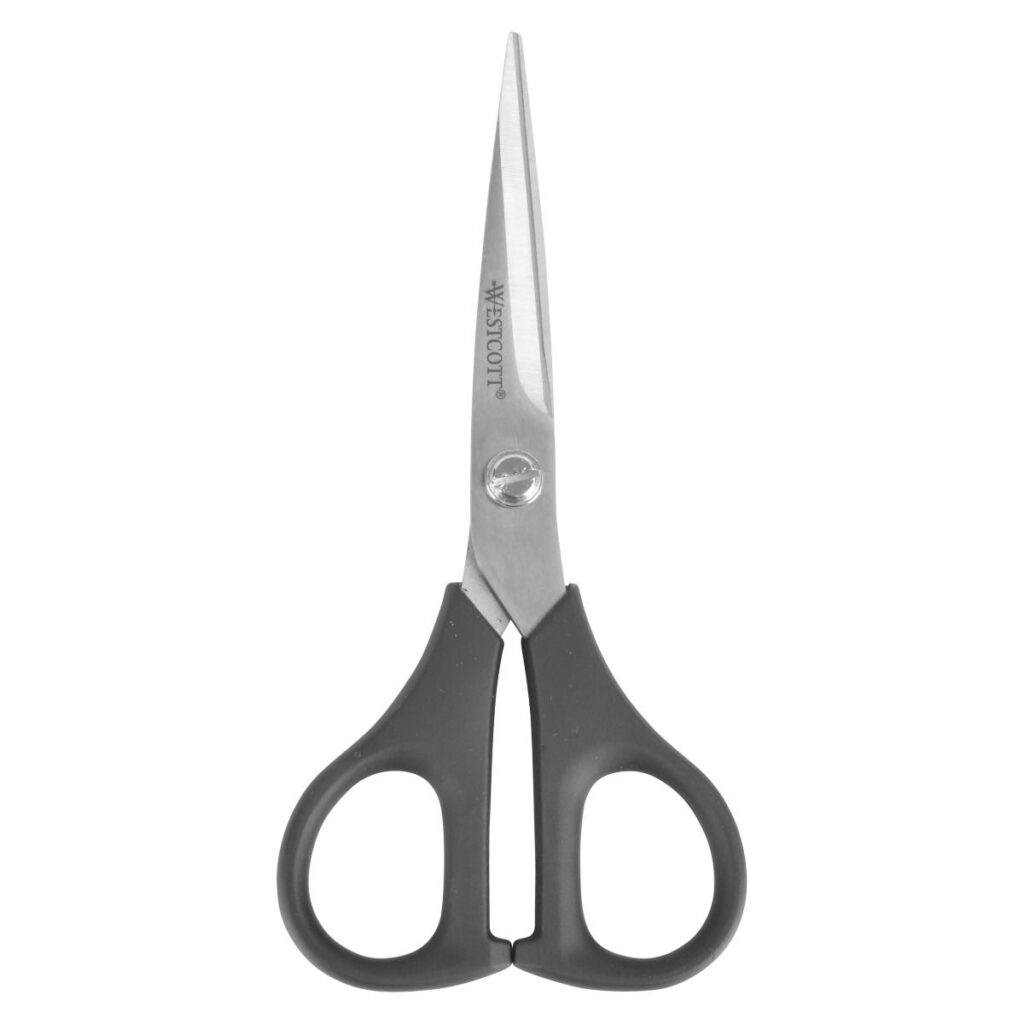
Fine cutting scissors abound. I have landed on Dr. Slick brand. They have been in business since 1998 and produce a reliable and quality product. If you look at all the designs available, the point of each of them is the same (or almost the same), so I recommend going with the “Hair” scissors as your first pair. They can do all the work the smaller versions cannot and can still get close on all fine work. I own a few specialty pairs but these are on the bench every day and should be your first ones. These will run you about $20.
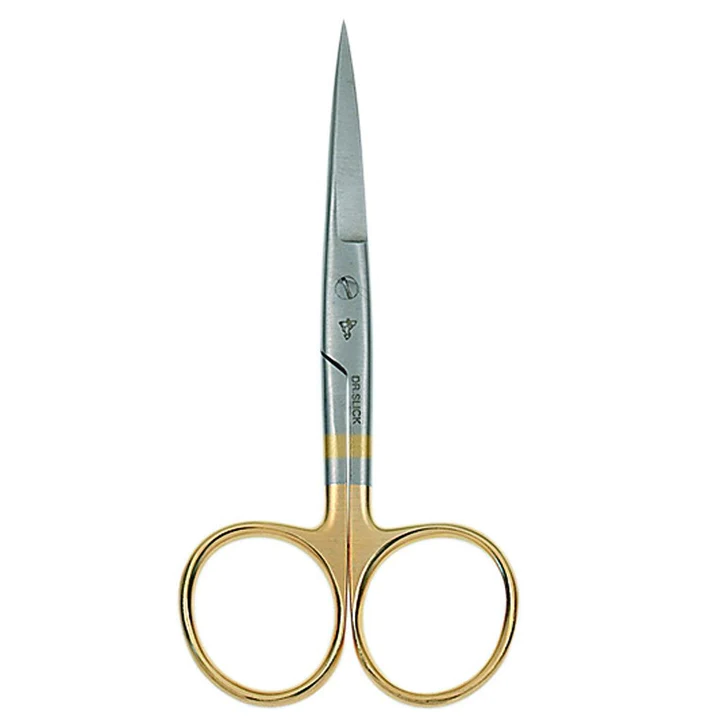
Fly Tying Thread Bobbin
A bobbin is used to hold your thread spool and give you full control as you wrap the thread around the hook and material. There are several barrel types on the market including brass, titanium, ceramic and glass-lined. I prefer and recommend the glass-lined 4″ model from Dr. Slick. These are affordable and will accommodate the widest range of thread types with the least amount of wear. As you get into heavier denier synthetic threads, wear and thread grating will become an issue with brass or even ceramic barrels. You can pick one up for around $10. Get yourself a couple to start.
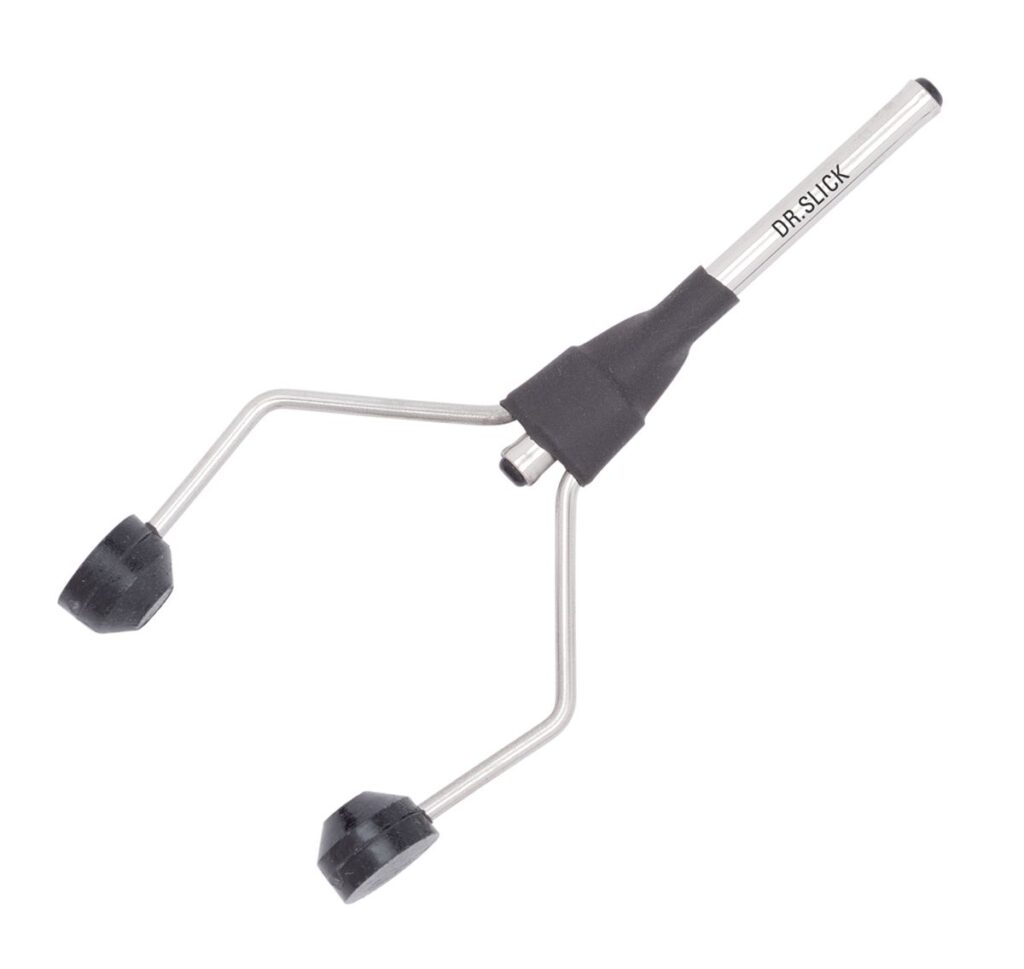
Hackle Pliers
Hackle pliers come in many designs and quality options. I started with the cheap plastic ones that have a plunger with a little hook on the end and went through several before landing on the one I use exclusively today. It is a simple spring model with a plastic cap on one side that is fine enough to grip the stem and closes securely without damaging the hackle or thread by Tiemco. You can get one for around $6.

Bodkin
This is a multi-purpose tool that you will use often. It can clear a hook eye, pick at dubbing, apply head cement and many more delicate operations that your fingers can’t accomplish. I prefer a 4″ model with a hexagon base so it stays put on the bench top. It should be all metal construction with a decent size shaft as you will be heating it with a lighter to clear hook eyes and burn off stray fibers. You can score one of these for about $5.
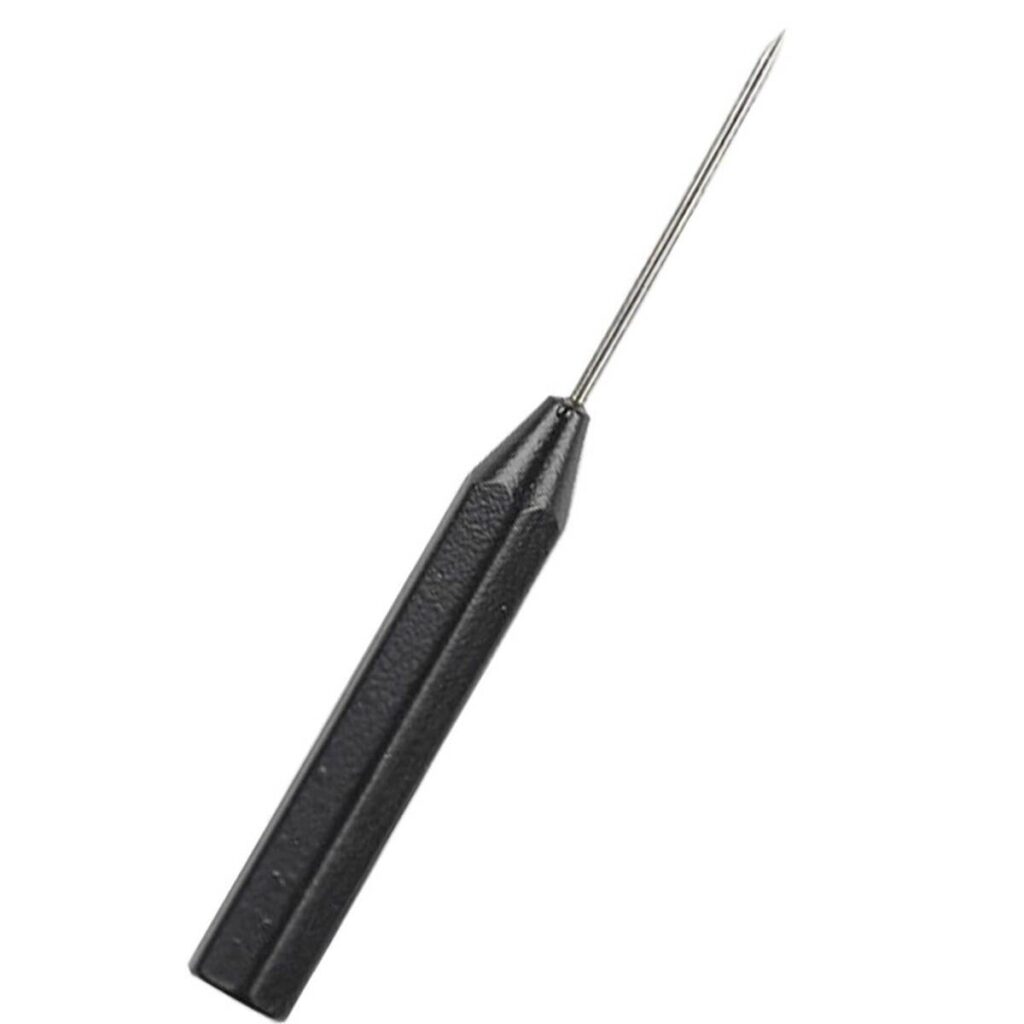
Whip Finish Tool
A whip finish tool is a one-trick pony but it does the trick very well. Even hand whip finish guys have one of these on the bench to get a final tie on parachute fly or other specific situations. I prefer the “bent style” vs. the “figure 4” style and I like the 4″ with a bamboo handle from Dr. Slick that has a half-hitch tool on the end. You can pick one up for about $13.
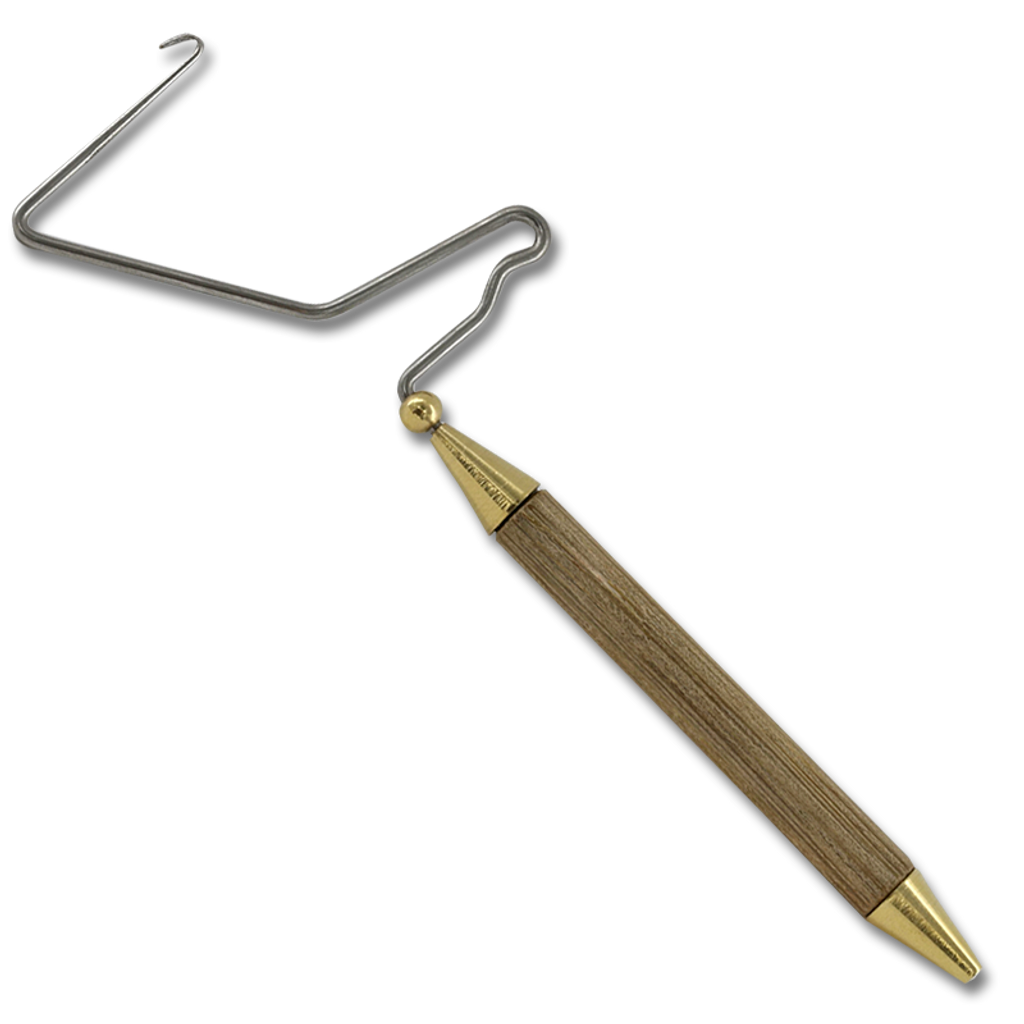
Hair Stacker
The Elk Hair Caddis fly pattern alone will dictate the next couple of tools. When dealing with hide hair (deer, elk, moose, etc), you will need a way to align the tips for tie in and clean the under-fur prior to stacking. The hair stacker is used for the former and this set from Renzetti can be had for about $20.
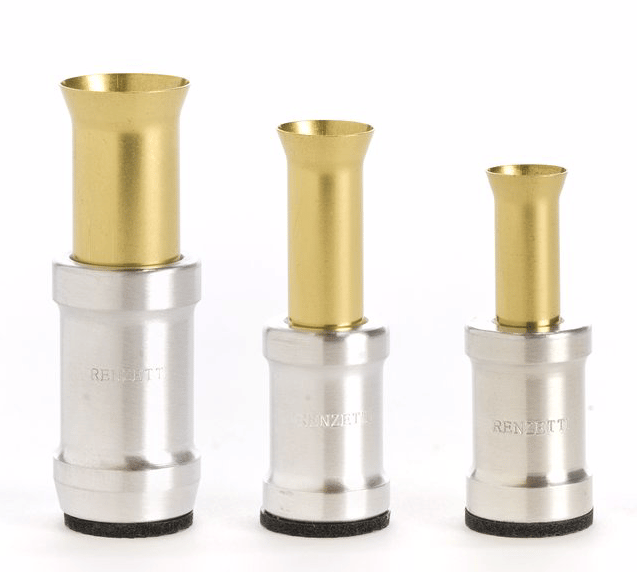
Hair Comb & Dubbing Brush
This tool from Stonfo is a great comb on one end for removing under-fur from hide hair and is a great dubbing brush for teasing out dubbing on the other. Pick one up for about $10.
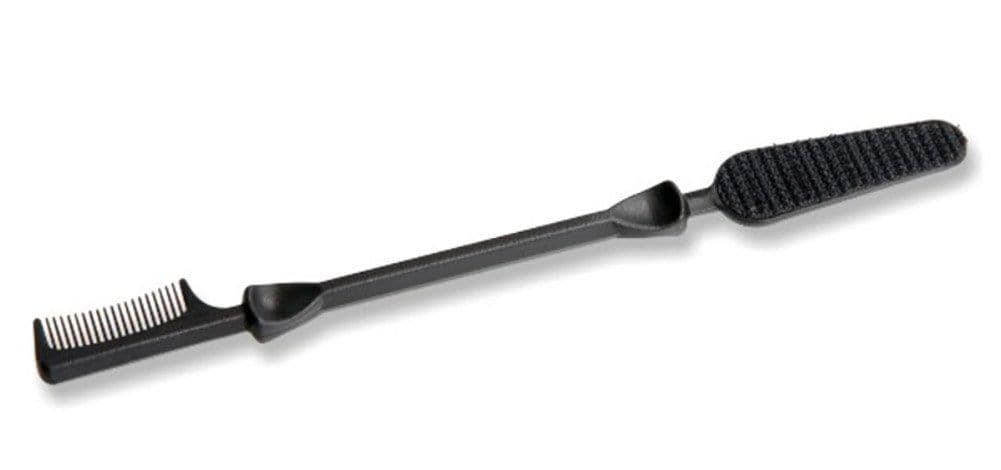
Dubbing Loop Spinner
For on-the-fly dubbing loops, you will need a dubbing spinner (dubbing twister). I prefer the design with two prongs instead of a single hook as it keeps the loop slightly open for help with inserting the material and closes easily with a little tension. This one from Dr. Slick has just the right weight and spins like a top. You can get one for about $8.

Fly Head Cement
Every fly I tie gets head cement on the final whip finish. I have never had a fly come untied so I keep doing it. I have gone through countless formulas and finally found a head cement that stays flexible and doesn’t dry out in the bottle over time. It is Loon Outdoors water-based head cement. It is a bit more expensive at $7.50 but it stays viable until the last drop. The first thing I do is trim the brush down to a fine point for accurate application.
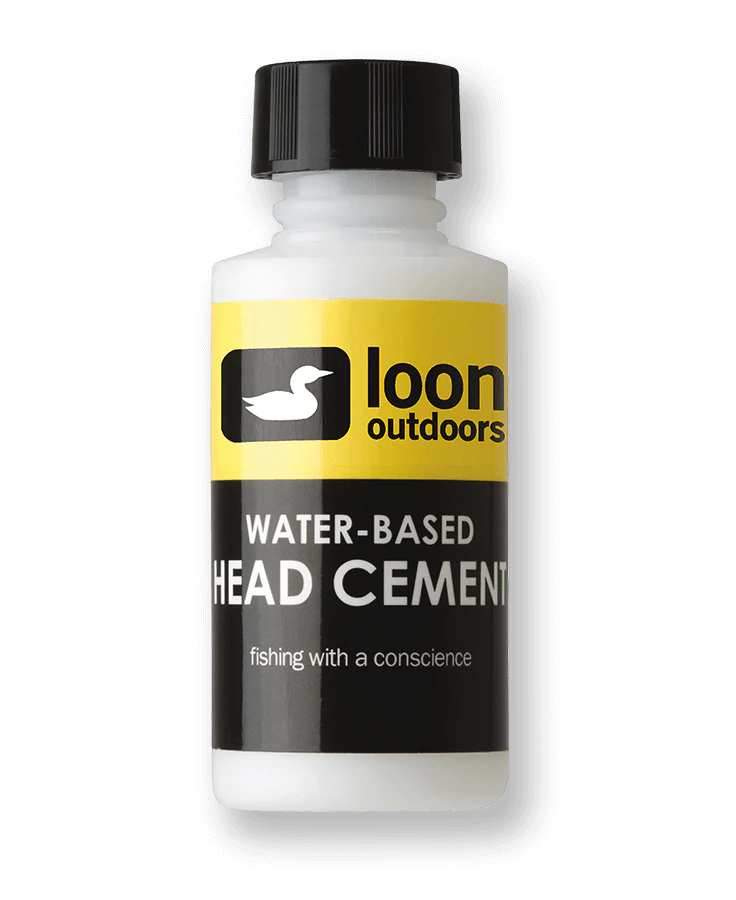
Dubbing Wax
Get the extra grip for dubbing application, spinning hair and on slick threads. A tube of Wapsi Premium Dubbing Wax seems to last for years. Get the “Regular”, avoid the “super sticky”. You can get a virtual lifetime supply for about $7.
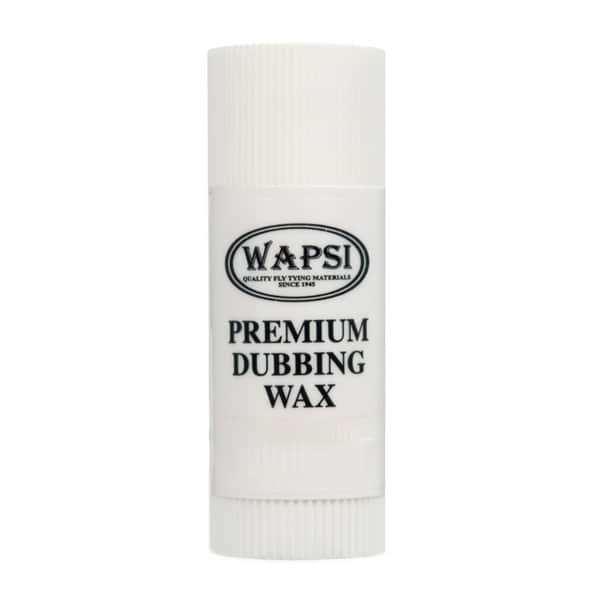
Fly Tyers Z-Ment
I have included this as basic equipment because almost every fly I tie has at least a little super glue on it somewhere. Used sparingly, it can add incredible durability. I have used many formulas and applicators over the years and none beats Fly Tyers Z-Ment from Wapsi. It has the perfect viscosity and sets in about 20 seconds. Same as the head cement, take your rough-cut scissors and snip the brush to a fine point. Also, rub the bottle cap threads with a generous amount of dubbing wax and it will prevent the cap from getting stuck over time. A bottle will set you back about $7.
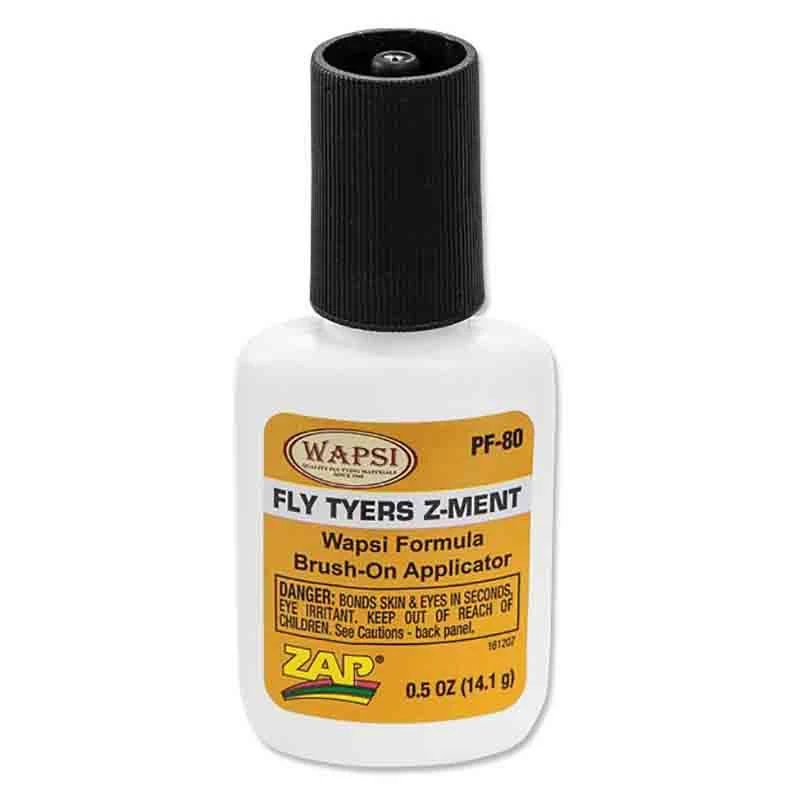
Fly Tying Tools Organizer
I worked for years without one and when I got it I couldn’t believe I waited so long. This may be pushing it as essential equipment but the cost/benefit is there and I recommend getting one sooner than later. You will thank me. There are several versions out there in different materials, but you can get this one from Renzetti for about $20.
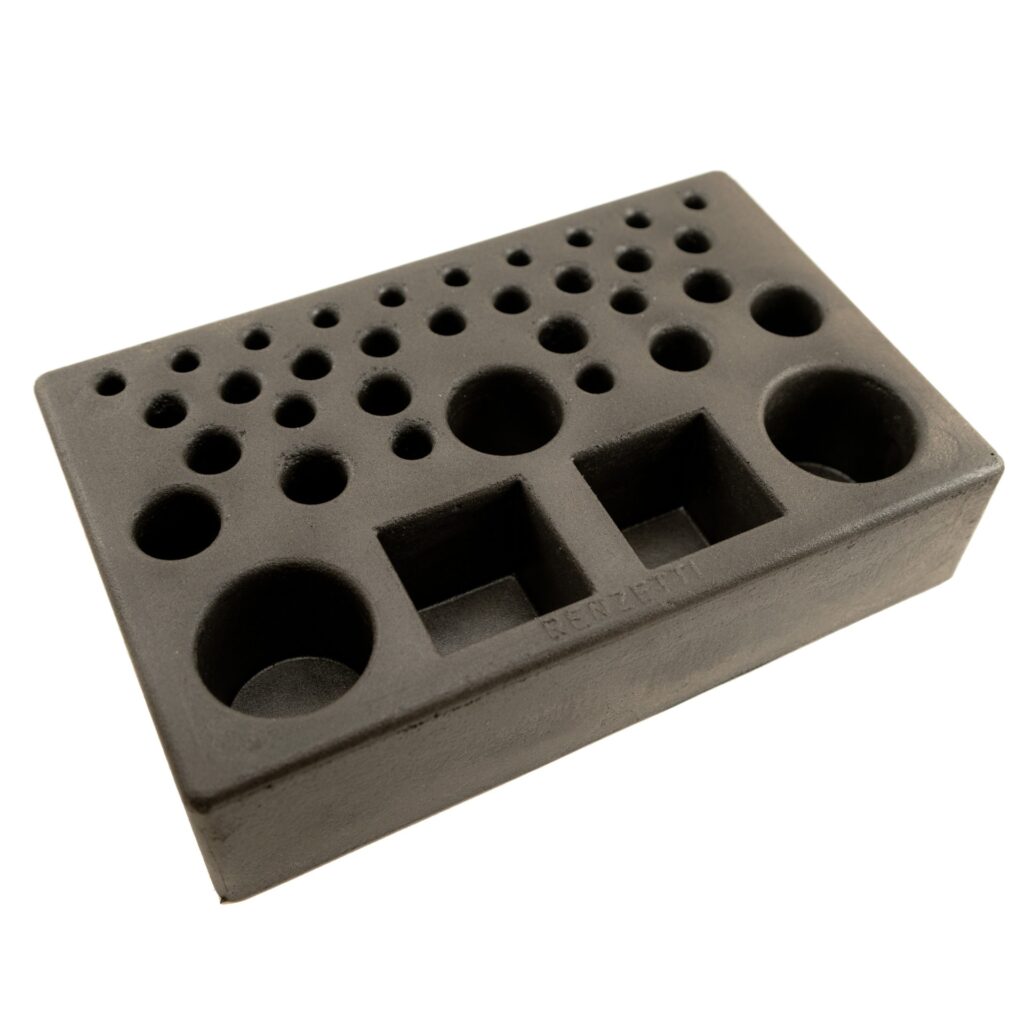
UV Resin System (depending on flies you tie)
I offer guidance here in case you determine you need to introduce UV resin into your fly tying in the beginning or at some point. I find it is great for backs on Copper John’s and some other nymph patterns. It is best applied in small amounts and built up to the final dimension. The problem with other systems is 1)the application with a tip applicator which is messy and hard to control and 2) the plastic bottle storage container which will allow it to get gel-like over time. Solarez Bone Dry solves those problems with a brush applicator and black-wrapped glass storage container. I have a rechargeable UV torch I picked up on Amazon but not sure what brand. It was cheap and still works great after several years. You can find this product for around $20.
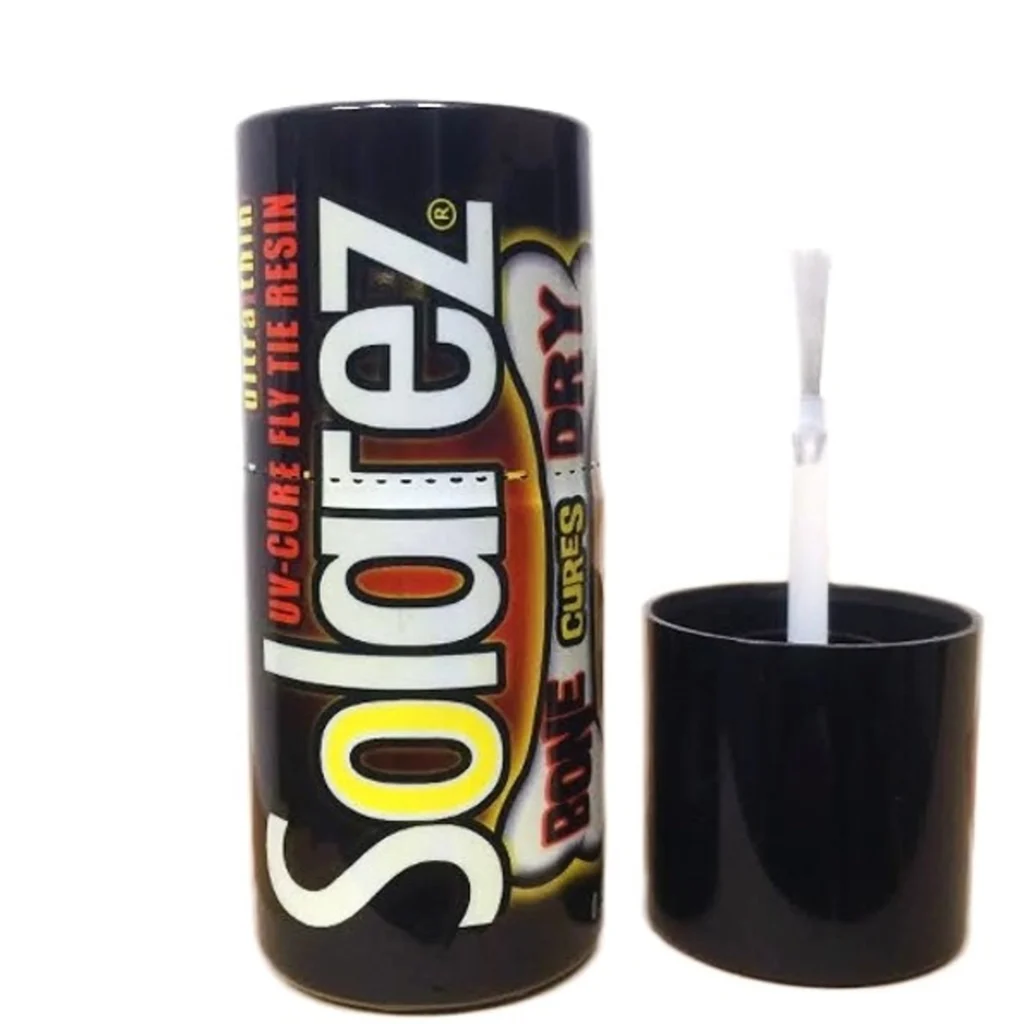
92 thoughts on “Fly Tying Tools – Getting Started the Right Way”
Hello,
I am new to fly tying and I want to thank you for this article. I have purchased the Peak rotary vise. I had been looking at kits, went to my local fly shop and ended up buying the vise with the pedestal base. It is very solid and stable. Now I am looking into the other tools needed to begin tying. I have been looking at the Dr. Slick line.
With your suggestions in the article, I’m going to go with your recommendations.
Dale – I am very pleased to hear you avoided the kit! I am also glad you found the article helpful in guiding your decisions. I sure wish I had this information when I first started.
Tight lines!
betzula
Betzula — это динамично развивающаяся IT-компания, которая занимается созданием современных технологических решений. Для того чтобы получить доступ к последним разработкам и ознакомиться с проектами, вы можете воспользоваться Betzula giris. Компания регулярно обновляет информацию, чтобы пользователи всегда могли найти свежие данные на Betzula guncel giris. Betzula также активно взаимодействует с аудиторией через социальные сети. Например, на Betzula Twitter можно следить за важными новостями, а мобильная версия Betzula mobil делает использование платформы максимально удобным. Независимо от того, работаете ли вы с компьютера или смартфона, вы сможете оценить удобство и функциональность решений компании.
Source:
– https://decodeistanbul.com/yorumlar/
Присоединяюсь. Я согласен со всем выше сказанным. Давайте обсудим этот вопрос.
if you interact resource in subsequent language, the winbay [url=https://bcgiso.com/luctus-non-massa-fusce-ac-turpis-quis/]https://bcgiso.com/luctus-non-massa-fusce-ac-turpis-quis/[/url] uses automatic translation in the window of the casino chat.
Хотите открыть свой тату салон, но не знаете, с чего стартовать? интернет-магазин MadMike предлагает качественное профессиональное инструментарий и расходники для мастеров тату.
В нашем каталоге вы найдете широкий ассортимент тату машинок, игл, чернил, аксессуаров от лучших брендов.
Выберите необходимое оборудоваине посетив наш тату шоп – https://madmike.com.ua/
Wandering through your site reminded me of the idyllic beaches of Seychelles, where the tranquility and beauty are both incredibly refreshing. The soothing color palette and inviting layout contribute to a sense of relaxation that keeps users coming back. I am grateful for the chance to share my thoughts on the beautiful work you’ve created.
You could visit my website if you’re inclined sCIENtIfIc STUDiEs ON bauXIteS
Explore the best online schools in Minnesota | Earn your degree from home with online schools in Minnesota | Convenient online schools in Minnesota for all students | Choose from a variety of online schools in Minnesota | Start your educational journey with online schools in Minnesota | Utilize the benefits of online education in Minnesota | Register for accredited online programs in Minnesota | Convenient options for online education in Minnesota | Personalized learning experiences at online schools in Minnesota | Match your goals with online schools in Minnesota
Online Schools in Minnesota [url=http://www.onlineschoolmn4.com]http://www.onlineschoolmn4.com[/url] .
Хотите открыть свой тату салон, но не знаете, с чего стартовать? интернет-магазин MadMike предлагает качественное профессиональное оборудование и расходники для художников тату.
В нашем каталоге вы найдете огромный выбор тату аппаратов, игл, чернил, расходных материалов от ведущих брендов.
Найдите необходимое оборудоваине посетив наш тату магазин онлайн – https://madmike.com.ua/
Почему протезирование зубов – мудрое решение, для уверенности и комфорта.
Платное протезирование зубов [url=https://www.belfamilydent.ru/services/protezirovanie-zubov]https://www.belfamilydent.ru/services/protezirovanie-zubov[/url] .
Хочешь узнать цену на металлокерамику?.
Стоматология коронки металлокерамика цена [url=https://www.belfamilydent.ru/services/metallokeramicheskie-koronki]https://www.belfamilydent.ru/services/metallokeramicheskie-koronki[/url] .
Explore the top online education options in South Carolina, Earn your degree without ever stepping foot on a campus.
Learn how online schools in South Carolina can fit into your busy schedule.
Convenient online education options in South Carolina.
Reasons to enroll in online programs in South Carolina.
Connect with top online schools in South Carolina.
Choose from a variety of online programs in South Carolina.
Embrace the digital age with online schools in South Carolina.
Flexible options for working professionals in South Carolina.
Achieve your goals with online schools in South Carolina.
Transform your future with online schools in South Carolina.
Online Schools in South Carolina [url=https://onlineschoolsc6.com]https://onlineschoolsc6.com[/url] .
Превосходное качество циркониевых коронок, гарантируют безболезненное установление коронок.
Циркониевая коронка поставить Минск [url=https://www.belfamilydent.ru/services/koronki-iz-cirkoniya]https://www.belfamilydent.ru/services/koronki-iz-cirkoniya[/url] .
Безболезненная базальная имплантация зубов: гарантия красивой улыбки в Минске.
Базальная имплантация цены [url=https://www.belfamilydent.ru/services/basal-implantation/]https://www.belfamilydent.ru/services/basal-implantation/[/url] .
Discover the top online schools in Tennessee, right here.
Interested in online schools in Tennessee?, Check out these top options.
Research the top online schools in Tennessee, with our comprehensive guide.
Ready to enroll in online schools in Tennessee?, Find all the information you need on this site.
We have the most up-to-date list of online schools in Tennessee, all in one place.
Discover the top benefits of online schools in Tennessee, by exploring our site.
Want to find reputable online schools in Tennessee?, Look no further.
Opt for the top online schools in Tennessee, based on our in-depth research.
Discover the ideal online schools in Tennessee for your needs, on our site.
Start your journey with online schools in Tennessee, with our guidance.
Online Schools in Tennessee [url=onlineschooltn1.com]onlineschooltn1.com[/url] .
эскортницы москва
Высокие стандарты обслуживания являются основой работы эскорт-агентств. Девушки проходят тщательный отбор, учитывающий их внешний вид, манеры и интеллектуальные качества. Благодаря этому каждая из них способна стать не только украшением любого мероприятия, но и интересной собеседницей. Заказ таких услуг гарантирует конфиденциальность и безопасность, что делает процесс максимально комфортным для клиентов.
Source:
– https://leopard-esc.online/modeli/elitnyi-eskort/
Ласкаво просимо до нашої студії тату та пірсингу в Житомирі!
Ми робимо унікальні шедеври, що підкреслюють вашу неперевершеність. У нас в команді працюють досвідчені майстри з великим досвідом, які використовують тільки нове обладнання та безпечні матеріали.
Мрієте про круте татуювання або гарний пірсинг? В нашій студії ви знайдете все для втілення ваших найсміливіших ідей. Подаруйте собі шанс виділитися з натовпу та висловити вашу особистість через мистецтво тату та пірсингу.
Приходьте до нашої студії Голка та переконайтеся в якості нашої роботи!
Зроби собі подарунок у вигляді Пірсінгу – https://golka.love/
Explore the best online schools in Iowa, on this website.
Join the ranks of successful students at online schools in Iowa.
Get ahead with online schools in Iowa.
Find the perfect online school in Iowa for your needs.
Learn from the best at online schools in Iowa.
Take the first step towards your dream job with online schools in Iowa.
Enjoy the flexibility of online schools in Iowa.
Discover the benefits of online schools in Iowa.
Connect with fellow students at online schools in Iowa.
Master your studies with online schools in Iowa.
Online Schools in Iowa [url=https://onlineschoolia7.com/]https://onlineschoolia7.com/[/url] .
Где найти информацию о ценах на стоматологические услуги в Минске?, посмотрите на нашем портале.
Стоматология Минск цены на услуги [url=https://dentistblog.ru/]Стоматология Минск цены на услуги[/url] .
для офиса | Эксклюзивное предложение на сканер Scanform L5 | Все преимущества сканера Scanform L5 | Надежный помощник – сканер Scanform L5 | Качественный сканер для профессионалов – Scanform L5 | Лучший инструмент для сканирования – Scanform L5 | Подробный обзор сканера Scanform L5 | Элегантный сканер Scanform L5 | Спецпредложение на сканер Scanform L5 | Scanform L5: инновации в сканировании
Scanform L5 [url=http://www.an-form-5.ru]http://www.an-form-5.ru[/url] .
эскорт модели москва
Эскорт услуги в МСК также отличаются своей универсальностью. Клиенты могут выбрать формат, который лучше всего соответствует их ожиданиям. Это может быть заказ эскортницы на час для непринуждённой беседы, длительное сопровождение в роли содержанки или выбор модели для подчёркивания статуса на важных мероприятиях. Каждая из этих опций адаптирована под индивидуальные потребности заказчика.
Source:
[url=https://leopard-esc.online/modeli/vip-modeli/]эскорт модели москва[/url]
Диагностика проходит бесплатно, но только в случае, [url=https://www.flashcom.it/2011/03/12/ciao-mondo/]https://www.flashcom.it/2011/03/12/ciao-mondo/[/url] если вы оставит девайс на небольшой ремонт в этом обслуживающем центре.
Онлайн образование на высшем уровне, для достижения ваших целей.
Получите качественное образование удаленно, гибкий график обучения.
Профессиональные преподаватели на платформе, готовых помочь вам каждый день.
Присоединяйтесь к лучшим онлайн курсам прямо сейчас, не откладывая на завтра.
Онлайн образование для каждого, с возможностью выбора курсов по интересам.
Преимущества онлайн обучения, которое уже здесь.
Онлайн обучение: ключ к знаниям, для достижения новых целей.
Онлайн школа: путь к успешному будущему, для достижения высоких результатов.
Онлайн курсы: современный подход к обучению, для вашего удобства.
Online School [url=http://www.privateschoolreview.com/legacy-online-school-profile/]http://www.privateschoolreview.com/legacy-online-school-profile/[/url] .
вип эскорт
Эскорт услуги в МСК — это не просто досуг, а возможность создать идеальную атмосферу для отдыха или работы. Они предлагают эстетическое удовольствие и эмоциональную поддержку, которые делают каждый момент особенным. Благодаря высокому уровню профессионализма девушек, клиенты получают не только красоту и элегантность, но и комфорт, который позволяет забыть о повседневных заботах.
Source:
[url=https://escort-moscow.pro/]вип эскорт[/url]
по интерактивным курсам.
с помощью онлайн обучения.
Станьте экспертом в своей области с онлайн курсами.
Учите новое без напряжения: интернет школа.
Получайте качественное образование удаленно.
Онлайн школа: выбор современного человека.
Образование на расстоянии через онлайн платформу.
Развивайтесь где угодно с онлайн курсами.
Занимайтесь удобно и эффективно через интернет.
Онлайн образование: выбор современного человека.
Online School [url=querianson.com/the-future-of-education-exploring-the-advantages-of-online-school]querianson.com/the-future-of-education-exploring-the-advantages-of-online-school[/url] .
А СЕРВЕР НЕ ПАШЕТ НА……
в год ее доля в доходах компании выросла с 28% до 32%. в это же время с 13% вплоть до 10,2% просела доля видео на любых вариантах носителей, [url=https://spiritnerd.org/dag-heward-mills-forgiveness-made-easy/]https://spiritnerd.org/dag-heward-mills-forgiveness-made-easy/[/url] а продажи музыки осталась на уровне 4% от всего оборота компании.
Best Online Schools for Teaching children, with many interesting courses.
Looking for home-based learning? Online schools will help you choose, find out all the advantages and disadvantages.
How to choose the best online school for yourself, understand the main points.
Secrets of successful learning at home for children, apply proven techniques.
Secrets of successful online learning, apply proven techniques.
Choosing between online and offline learning: which is better?, evaluate all the pros and cons.
Choose interesting online courses to learn a new language, improve your skills.
Learning at an online school: how not to lose motivation, get useful tips.
Secrets of comfortable learning at home, improve your learning environment.
Online learning vs traditional learning methods: which is better?, make the right choice.
Best Online Adult Schools: Choose your Learning Path, improve your skills.
How to properly study online, overcome difficulties.
How to choose the best online school for learning programming, improve your skills.
Online learning: a new format of education, develop with us.
How to improve the quality of education for children in an online school, get the most out of it.
How to organize online education for your child at home, apply proven techniques.
Why choose online education for children, get new knowledge.
onlineschool [url=http://www.onlk12-st5.com]http://www.onlk12-st5.com[/url] .
Heya, homie! Missed hangin’ with you, awesome friend.
Scrolling through this site transported me to an exotic jungle resort in Costa Rica, where nature’s beauty is front and center. The vibrant imagery and inviting design create a space that beckons for exploration. I’m thankful for the chance to voice my admiration for this marvelous site!
Bon voyage, and goodbye, and may adventure await you
Unshaved teen chicks and furred Milf spreads legs in addition to closeup bushy pussies. Seem hairy girls at candid porn pictures! [url=https://hairybeautypics.com/]hairy women pussy pictures[/url] Hispid pussy pics with hundreds of hirsute hotties in our hulking unconditional hairy bush collection. Hand-selected and categorized precarious pictures. [url=https://hairybeautypics.com/]beautiful hairy pussy pics[/url] Unshaved teen chicks and furry Milf spreads legs and closeup bushy pussies. Look hispid girls at impartial porn pictures!
hairy granny porn blog
busty teen hairy pictures
very hairy ass
[url=https://hairybeautypics.com/hairy-pussy-dildo/]hairy dildo porn pics[/url]
Heyo, future bestie! I’m pumped to get to know you better, let’s do this.
Your site takes me on a serene walk through Joshua Tree National Park, with breathtaking graphics and a calming color palette that invites exploration. As a knowledgeable park ranger, you’ve captured the essence of nature’s beauty!
Your website is like a decadent chocolate mousse, rich and dreamy! I’d love to have a dessert creator like you join my kitchen Copper content analysis
Keep shining, and may your spirit soar
Обзор FreeScan UE Pro: лучший инструмент для сканирования, Проверьте свой сайт с помощью FreeScan UE Pro, Повысьте уровень безопасности вашего сайта с FreeScan UE Pro, Как улучшить SEO с помощью FreeScan UE Pro, Узнайте все о FreeScan UE Pro: плюсы и минусы, 7 полезных советов по работе с FreeScan UE Pro, Полный контроль над аудитом сайта с FreeScan UE Pro, Сделайте свой сайт более эффективным с помощью FreeScan UE Pro, FreeScan UE Pro: инструмент для успешной оптимизации веб-ресурсов, Учебник по оптимизации сайта с помощью FreeScan UE Pro
shining 3d freescan ue pro купить [url=https://www.reesc-ro5.ru]https://www.reesc-ro5.ru[/url] .
[url=https://888starz.bet/]детская порнография[/url]
Hei, amazing person! I’m excited to discover the wonderful you.
Visiting this site feels like being part of the lively Oaxacan Guelaguetza Festival, where the celebration of indigenous culture shines brilliantly. The colorful designs and engaging content inspire me to learn more about diverse traditions and stories. I’m grateful for the chance to share my thoughts and commend the team’s efforts. A visit from you would inspire me to enhance my site even further Aluminium scrap sampling
Arrivederci, and may your heart be filled with love
Ayy, fellow awesome sauce! Let’s be pals, for sure.
Navigating your website was like embarking on a peaceful canoe journey down a tranquil river, with nature’s beauty guiding me effortlessly. The serene aesthetics and informative content make it feel like I have a skilled paddler leading me through calm waters.
I encourage you to check my website Who buys scrap batteries
Fare thee well, and may warmth fill your days
Перейти до вмісту
tradinginfo
Аналітика
Навчання
Криптовалюта
Трейдинг
Компанія
Консультація
Пошук…
Навчання трейдингу
Навчання трейдингу, курси трейдингу в Львів, Київ, Одеса, Чернівці, Харків, Ужгород, Вінниця, Тернопіль, Запоріжжя, Івано-Франківськ, Полтава, Чернігів, Черкаси, Суми, Луцьк, Миколаїв, Дніпро, Кропивницький, Рівне, Хмельницький, Житомир, Херсон та онлайн. Індивідуальні заняття з практикуючими трейдерами. Криптовалюта, Валютні ринки, Фондові ринки.
Навчання криптовалюта
Криптовалюта з чого почати
Рівень: початковий
Кількість уроків: 10-30
Детальніше
Навчання по криптовалюті
Рівень: початковий
Кількість уроків: 10
Детальніше
Трейдинг криптовалют
Рівень: початковий, середній
Кількість уроків: 10
Детальніше
Блокчейн навчання
Рівень: початковий, середній
Кількість уроків: 10
Детальніше
Курс “10 кращих крипто стратегій”
Рівень: середній
Кількість уроків: 10
Детальніше
Навчання трейдингу
Безпечний трейдинг
Рівень: початковий
Кількість уроків: 5
Детальніше
Трейдинг для початківців
Рівень: початковий
Кількість уроків: 10
Детальніше
Курси трейдингу онлайн
Рівень: початковий
Кількість уроків: 10
Детальніше
10 кращих стратегій трейдингу
Рівень: середній
Кількість уроків: 10
Детальніше
Smart Money Курс
Рівень: початковий
Кількість уроків: 10
Детальніше
Навчання трейдингу в офісах
Навчання трейдингу Київ
Рівень: початковий, середній, профі
К-сть уроків: 5-30
Детальніше
Навчання трейдингу Харків
Рівень: початковий, середній, профі
К-сть уроків: 5-30
Детальніше
Навчання трейдингу Львів
Рівень: початковий, середній, профі
К-сть уроків: 5-30
Детальніше
Навчання трейдингу Рівне
Рівень: початковий, середній, профі
К-сть уроків: 5-30
Детальніше
Навчання трейдингу Дніпро
Рівень: початковий, середній, профі
К-сть уроків: 5-30
Детальніше
Навчання трейдингу Одеса
Рівень: початковий, середній, профі
К-сть уроків: 5-30
Детальніше
Навчання трейдингу Івано-Франківськ
Рівень: початковий, середній, профі
К-сть уроків: 5-30
Детальніше
Навчання трейдингу Луцьк
Рівень: початковий, середній, профі
К-сть уроків: 5-30
Детальніше
Навчання трейдингу Тернопіль
Рівень: початковий, середній, профі
К-сть уроків: 5-30
Детальніше
Навчання трейдингу Чернівці
Рівень: початковий, середній, профі
К-сть уроків: 5-30
Детальніше
Навчання трейдингу Хмельницький
Рівень: початковий, середній, профі
К-сть уроків: 5-30
Детальніше
Навчання трейдингу Ужгород
Рівень: початковий, середній, профі
К-сть уроків: 5-30
Детальніше
Навчання трейдингу Вінниця
Рівень: початковий, середній, профі
К-сть уроків: 5-30
Детальніше
Навчання трейдингу Полтава
Рівень: початковий, середній, профі
К-сть уроків: 5-30
Детальніше
Навчання трейдингу Житомир
Рівень: початковий, середній, профі
К-сть уроків: 5-30
Детальніше
Навчання трейдингу Запоріжжя
Рівень: початковий, середній, профі
К-сть уроків: 5-30
Детальніше
Навчання трейдингу Херсон
Рівень: початковий, середній, профі
К-сть уроків: 5-30
Детальніше
Навчання трейдингу Суми
Рівень: початковий, середній, профі
К-сть уроків: 5-30
Детальніше
Навчання трейдингу Черкаси
Рівень: початковий, середній, профі
К-сть уроків: 5-30
Детальніше
Навчання трейдингу Чернігів
Рівень: початковий, середній, профі
К-сть уроків: 5-30
Детальніше
Чому трейдери обирають TradingInfo
Навчання Форекс та криптовалюта. З нами кожен знайде курс для себе:
навчання трейдингу криптовалют
здобуття навичок короткотермінової і середньотермінової торгівлі
алготрейдинг
психологія торгівлі
торгові стратегії для крипто та форекс ринку
навчання торгівлі на Форексі
біткоін курси
форекс торгові стратегії
Навчання трейдингу
Команда професійних трейдерів розробляє курси виходячи зі свого досвіду, зміни ринку і сучасних методик, які допомагають в найкоротші терміни освоїти матеріал і вийти на новий рівень прибутку.
Тебе чекає оптимальний мікс теорії і практики, відсутність “водички” і всебічна підтримка наставника.
Ви можете пройти навчання трейдингу Львів, Київ, Одеса, Чернівці, Харків, Ужгород, Вінниця, Тернопіль, Запоріжжя, Івано-Франківськ, Полтава, Чернігів, Черкаси, Суми, Луцьк, Миколаїв, Дніпро, Кропивницький, Рівне, Хмельницький, Житомир, Херсон та онлайн.
Як відомо, навчання Форекс з наставником проходить швидше, дає кращі результати та обходиться дешевше. Так як помилки новачків можуть коштувати їм не одного депозиту, тоді як робота з досвідченим трейдером допоможе скоротити втрати в рази.
Вибирайте відповідний курс і вчіться за авторською методикою.
tradinginfo
Все про фінансові ринки. Криптовалюта, Біткоін, Форекс, Акції. Торгові стратегії. Торгові сигнали. Навчання трейдингу.
Контакти
Львів, проспект В’ячеслава Чорновола, 77 (ЖК Платинум)
+380934125348
info@tradinginfo.club
Facebook
Instagram
Telegram
Аналітика
Аналітика валют
Аналітика криптовалют
Аналітика фінансових ринків
Аналітика фондового ринку
Індекс страху і жадібності криптовалют
Таблиця прогнозу спільноти форекс
Теплова карта криптовалют
Форекс економічний календар
Прогноз EUR/USD
Прогноз GBP/USD
Прогноз USD/UAH
Навчання
Навчання
Курс Smart Money
Безпечний трейдинг
Блокчейн навчання
Криптовалюта з чого почати
Курси трейдингу онлайн
Навчання по криптовалюті
Навчання трейдингу Київ
Навчання трейдингу Львів
Навчання трейдингу Одеса
Трейдинг для початківців
Трейдинг криптовалют навчання
Трейдинг
Price Action
Книги про трейдинг
Основи трейдингу
Словник трейдера
Технічний аналіз
Технічні індикатори
Торгові стратегії
Трейдинг
Успішні трейдери
Фондовий ринок
Фундаментальний аналіз
Криптовалюта
Біткоін
Блокчейн
Криптовалюта
Криптовалюти
Криптовалютні гаманці
Основи криптовалюти
Словник криптотермінів
Теплова карта криптовалют
Торгівля криптовалютою
Курс Bitcoin (BTC)
Курс Ethereum (ETH)
Курс Solana (SOL)
Курс Dogecoin (DOGE)
Курс Ripple (XRP)
© 2024 TradingInfo. Всі права захищено.
Політика конфіденційності
Відмова від відповідальності
Відмова від відповідальності
Компанія не надає гарантій заробітку на біржах в якій би то не було формі. Компанія не займається діяльністю, яка підлягає ліцензуванню. Компанія не займається брокерським обслуговуванням. Компанія не займається довірчим управлінням. Компанія не залучає позики у населення.
Open chaty
[url=https://redmetsplav.ru/store/vismut/zarubezhnye-splavy-3/vismut-l54830—uns/lenta-vismutovaya-l54830—uns/]Лента висмутовая L54830 – UNS[/url]
Лента висмутовая L54830 – UNS является высококачественным материалом, имеющим широкое применение РІ различных отраслях. РћРЅР° идеально РїРѕРґС…РѕРґРёС‚ для электроники, медицины Рё РґСЂСѓРіРёС… профессиональных областей благодаря СЃРІРѕРёРј уникальным свойствам. Лента обладает отличной стойкостью Рє РєРѕСЂСЂРѕР·РёРё Рё высоким температурам, что делает её надежным выбором для вашего проекта. Если РІС‹ ищете надежный Рё долговечный материал, вам стоит купить Лента висмутовая L54830 – UNS. Сделайте шаг Рє качеству, выбирая этот РїСЂРѕРґСѓРєС‚ для СЃРІРѕРёС… потребностей!
РедМетСплав предлагает широкий ассортимент качественных изделий из редких материалов. Не важно, какие объемы вам необходимы – от небольших закупок до масштабных поставок, мы гарантируем своевременную реализацию вашего заказа.
Каждая единица изделия подтверждена соответствующими документами, подтверждающими их происхождение. Опытная поддержка – наш стандарт – мы на связи, чтобы разрешать ваши вопросы по мере того как адаптировать решения под требования вашего бизнеса.
Доверьте потребности вашего бизнеса специалистам РедМетСплав и убедитесь в множестве наших преимуществ
поставляемая продукция:
[url=https://redmetsplav.ru/store/kobalt/stellite/kobalt-stellite-694/izdeliya-iz-kobalta-stellite-694/]Рзделия РёР· кобальта Stellite 694[/url]
[url=https://redmetsplav.ru/store/volfram/splavy-volframa-1/volfram-vn-5-2/poroshok-volframovyy-vn-5/]Порошок вольфрамовый ВН-5[/url]
[url=https://redmetsplav.ru/store/titan/rossiyskie-splavy-4/titan-t20—gost-2171-90/list-titanovyy-t20—gost-2171-90/]Лист титановый Рў20 – ГОСТ 2171-90[/url]
[url=https://redmetsplav.ru/store/niobiy1/splavy-niobiya-1/niobiy-4e-1/poroshok-niobievyy-4e/]Порошок ниобиевый 4Р[/url]
[url=https://redmetsplav.ru/store/magniy-i-ego-splavy/zarubezhnye-splavy-2/magniy-r60704—uns/list-magnievyy-r60704—uns/]Лист магниевый R60704 – UNS[/url]
[url=https://bit.ly/3EGKSVc][img]https://tripacostarica.com/1/tp/sr/1.png[/img][/url]
[b][u]Imagine[/u][/b] yourself located on the deck of a vessel, a soft breeze fluttering with your hair, and around you opening up an endless horizon, where the waves connects with the sky. There is no disturbance of cities, no roar of cars, just you and nature in its natural beauty. Using a ship is not just a excursion, it is an opportunity to grasp absolute independence of action and a intense union with the surrounding world, which is difficult to obtain in routine life. Why not do this step immediately?
Independence is what is so lacking in the current woman, stuck in schedules, responsibilities and infinite notifications. When you lease a ship, you become the helmsman of your course. Want to go to a private beach where no one interrupts your solitude? Please! Want to venture into secret bays and islands that only resident fishermen know about? Easy! No rigid routes, no obstacles — just you and your dreams. You can rise at dawn to see the sun painting the water in yellow hues, or employ the day snorkeling among coral reefs bursting with life. Renting a boat gives you ability, allowing you to seem as unrestricted as the wind that swells the sails.
[url=https://bit.ly/3EGKSVc][img]https://tripacostarica.com/1/tp/sr/2.png[/img][/url]
[b][u]But[/u][/b] freedom is only one side of the marker. The other is a profound connection with wildlife that cannot be felt while sitting in an workplace or sauntering on surface. The sea is a living organism that breathes, reveals and sometimes challenges. Listening the sound of the surf, inhaling the salty air and admiring the ballet of the dolphins, you begin to grasp how petty our daily bustle is compared to the majesty of nature. Ship becomes your passage into this world: you can set anchor in the middle of the water, to reflect on the stars that seem more accessible than ever, or set up a picnic on the deck, immersed only by the rustles of nature.
Renting a boat suits not only solo travelers seeking personal peace, but also for those who esteem communication. Visualize this: you with loved ones or household heading out on a trip, telling stories under the cosmos, playing social games on the deck, or simply savoring the silence together. Yacht becomes your individual haven, where there is no room for dull routines or outside distractions. You can plan a loving dinner at sunset, gazing at as the sky becomes a palette of reddish and rich shades, or host a energetic party with music and moves under the clear sky. Every moment on the motorboat is a chance to create experiences that will soothe you for endless years.
[u][b]Of course[/b][/u], booking a vessel is also an way to enjoy convenience. Advanced boats are equipped with all the needed: from wide cabins and kitchens to spas and entertainment systems. You can imagine like you’re at a luxury resort, but with the plus of full mobility. Want to moor in a place where there isn’t a single accommodation? No problem! A boat will carry you where no train or airplane can reach. This notion of specialness and freedom makes hiring a boat a singular experience that cannot be compared with anything else.
[url=https://bit.ly/3EGKSVc][img]https://tripacostarica.com/1/tp/sr/3.png[/img][/url]
But the [b][u]most vital[/u][/b] thing is that using a boat is accessible to anyone who dreams of liberty and ventures. You don’t have to be an trained sailor — expert crews and simple vessels will make your voyage safe and satisfying. You can decide on a yacht of any dimension and category: from little models for lovers to opulent vessels for large gatherings. The method of renting is clear: just determine your preferences, decide on a route, and confide in the professionals. In just a few days, you will be able to sit on the deck, noticing your heart beat in harmony with the rolls.
Don’t postpone your hopes for later. Full freedom of action and deep harmony with the world are waiting for you. Book a ship immediately and uncover a world where there are no restrictions except those you define yourself. Water calls — heed its cry, and you will understand what true liberty is. It’s not just a expedition, it’s a approach that inspires, revives, and permeates with value. Start the first step — and let the wind lead you to where visions become fact!
Complete freedom of action and deep unity with nature!
[url=https://bit.ly/3EGKSVc][b]Try it right now )[/b][/url]
Hi there are using WordPress for your blog platform? I’m new to the blog world but I’m trying to get started and create my own. Do you require any coding expertise to make your own blog? Any help would be really appreciated!
[url=https://9humantypes.com]Steps to merge God-given talents into your service[/url]
[url=http://daytonaparkestates.com/forum/index.php?topic=2.new#new]The contribution of God-given talents to individual ministry[/url] cf9dc04
Validating Qualified Experts and Steering Clear of Advance Charges
Homeowners should ensure they employ licensed contractors for covering tasks and be wary of roof businesses that request for the full amount beforehand. Certified professionals are more likely to be trustworthy and high-quality services, as they adhere to regulations and are responsible for their services. Non-qualified providers might cut corners or offer inferior results, causing likely complications and future costs. Furthermore, reputable roofing companies generally request a fair down payment with balance completed upon completion. Agreeing to pay the complete price up front can leave homeowners at risk to fraud or unfinished tasks. Confirming certification and equitable payment agreements is vital for ensuring property owners’ interests.
To illustrate A dweller contracts a covering firm that requests for the whole payment beforehand. After paying, the company completes a low-quality task and declines to fix the concerns until additional money is provided. The resident ends up with a badly completed roof and more charges to fix the task.
For the purpose of illustration An property owner verifies they contract a licensed contractor and complies to an appropriate payment plan. The expert fulfills the work as scheduled and excellently, leaving the homeowner pleased with the outcome and secure from possible concerns.
[url=https://portcityexteriors.com/roofing-castle-hayne-nc/]Roof warranty options around Southport North Carolina[/url]
[url=http://www.lycantic.com/forum/viewtopic.php?f=6&t=872533]Extending the Lifespan of Your Roofing[/url] 362d924
на этом сайте [url=https://lk-mango-office.com]Mango-Office интеграция с 1С[/url]
содержание [url=https://lk.mango-office.cc]Mango-Office услуги для бизнеса[/url]
узнать больше [url=https://lk.mango-offic.info/]Манго Офис личный кабинет[/url]
Read More Here [url=https://them-rril-lynch.net]mymerrill login[/url]
Смотреть здесь [url=https://smmbig.ru]накрутить просмотры телеграм[/url]
blog link [url=https://trustservice.io]Get SMS[/url]
подробнее здесь [url=https://kentcasino.io/]игровые автоматы r7[/url]
next https://cwap.us/
useful site https://noon.lat
browse this site https://perena.us
this website [url=https://themerr-ll-lynch.com/]merrill lynch[/url]
[url=https://kra–31.at/]kra31[/url] – кракен официальная ссылка, кракен купить
[url=https://https-kra31.at/]kra30 сс[/url] – кракен вход, kraken официальный сайт
[url=https://kra–31.cc/]кракен вход[/url] – кракен ссылка, кракен открыть
[url=https://9humantypes.com/about]The purpose of Holy Spirit gifts in faith formation[/url]
[url=https://spaanddeck.com/good-specialty-signs/]Enneagram spiritual development[/url] 04a5_19
проверить сайт [url=https://falcoware.com/rus/match3_games.php]скачать матч3 игры[/url]
ссылка на сайт [url=https://xn—–6kcacs9ajdmhcwdcbwwcnbgd13a.xn--p1ai]томск стоматология[/url]
этот контент[url=https://hyip-helper.net]купить хайп проект под ключ[/url]
Licensed Roofers in Wilmington N.C.
Staying by the seaside brings many advantages: briny air, stunning views and the unmistakable noise of surf pounding against the beach are among them. But being there also presents unique difficulties: gales, precipitation and the constant salt-filled breeze can affect negatively on roofing surfaces causing drips, moisture intrusion and potentially fungus formation beneath shingles or roof coverings, thus necessitating hiring an expert roofer in Wilmington North Carol to resolve these problems efficiently. That is why having access to dependable roofers experts in Wilmington North Carol is vital!
Roofing experts licensed with the North Carolina can assess possible problems and take preventative steps to keep rooftops in good shape – this could cut money in fixes while ensuring a safer working environment or residential area for employees or occupants.
These businesses focus in home and commercial roof services such as metal roof fittings, foam roof applications, reflective roof coating projects, shingle repair methods, full replacements of both residential and industrial rooftops and maintenance services. Furthermore, they can take care of installations for residential associations to meet regulations.
Roofers licensed in Wilmington must carry coverage and bonding insurance when performing roofing at residences and commercial sites, to safeguard residents against potential injuries that may take place during a task and guarantee their roof is repaired or substituted by skilled professionals. Furthermore, it helps the property owner verify whether their chosen authorized roof contractor has the experience and ability to deliver premium solutions.
[url=https://portcityexteriors.com/roofing-fayetteville-nc/]Speedy roof assessment around Wilmington NC[/url]
[url=https://sunlightbulb.com/lw/upload/forum.php?mod=viewthread&tid=100463&extra=]Addressing Rooftop Damage from Lightning[/url] 92448bf
кликните сюда [url=https://vodkacasino.net/]водкабет[/url]
Say goodbye to outdated liquidity tools—Balancer is here to transform your DeFi journey. Whether you’re exploring Balancer token (BAL), participating in Balancer airdrop vesting, or navigating Balancer Drop, the Balancer app gives you seamless access and full control. Dive into Balancer liquidity, manage your Balancer Portfolio, and track everything with Balancer Mirror. Check Balancer reviews, learn about Balancer pricing, and join the movement at https://balancer.ac !
New to trading on Solana? Phoenix Trade is leading the way with a high-speed, zero-order book Solana DEX experience. Built for power users, Phoenix Trade offers deep liquidity, lightning-fast execution, and secure Phoenix Trade Wallet integration. Curious about Phoenix Trade Review? Traders love the platformтАЩs low Phoenix Trade Fees and solid Phoenix Trade Security. Want to know Phoenix Trade Tutorial? ItтАЩs simpleтАФjust Phoenix Trade Login and explore the features. Ready to start? Visit https://phoenixtrade.me and experience the future of decentralized trading today!
Say hello to Super Sushi Samurai—the ultimate crypto game experience! Earn with Super Sushi Samurai land, explore the Super Sushi Samurai land map, and boost your gameplay using Super Sushi Samurai strategy and Super Sushi Samurai tips. Whether you’re collecting Super Sushi Samurai NFT items or gearing up for the Super Sushi Samurai airdrop, the SSS game delivers nonstop action. Want in? Buy SSS token and join the community on Super Sushi Samurai Telegram. Play now at https://sssgame.ink !
Say hello to Marinade Finance—the smarter way to stake on Solana! With Marinade staking, your Marinade SOL turns into Marinade Staked SOL, unlocking liquidity through Marinade mSOL. The platform is powered by the community via Marinade DAO and the MNDE token. Wondering about Marinade vs Lido? Users trust Marinade for its strong APY and proven Marinade Finance Audits. Start staking now at https://marinade.ink and grow your Solana securely!
Exploring token management? Liquifi is revolutionizing crypto with seamless, automated solutions. From Liquifi vesting to Liquifi Claim and Liquifi Receive, itтАЩs built for teams, DAOs, and protocols. With secure Liquifi token vesting and transparent Liquifi airdrop vesting, users gain total control. Curious about Liquifi reviews? Users love the experience and top-tier Liquifi security. Want to know Liquifi tutorial? ItтАЩs simpleтАФstart with the Liquifi app and scale with ease. Ready to go? Liquifi sign up now at https://liquifi.tech and streamline your vesting today!
Sky Money is building a better DeFi world! With SKY token, Sky Savings Rate, and seamless SKY token rewards, you’re always in control. Powered by Sky Protocol and connected to MakerDAO Sky and Spark Protocol Sky, it’s fully integrated and ready for serious users. Explore the Sky Atlas, stake sky ETH, and grow with the Sky ecosystem. Sky where to start? Visit https://skymoney.net and take flight with Sky crypto today!
Hello, you used to write wonderful, but the last few posts have been kinda boringK I miss your great writings. Past few posts are just a little out of track! come on!
check my reference https://xmaquina.net
txl4dd
her explanation [url=https://bazaar-darknet-market.com/]abacus darknet[/url]
этот сайт [url=https://kra-34c.cc/]кракен официальная ссылка[/url]
выберите ресурсы [url=https://kra33-at.at/]kra33.at[/url]
подробнее [url=https://t.me/s/pinco_zerkala/]скачать приложение pinco[/url]
опубликовано здесь [url=https://kra34at.at/]kra34.at[/url]
additional hints [url=https://russian-traditional-clothes.com]russian traditional clothing[/url]
I got good info from your blog
Write more, thats all I have to say. Literally, it seems as though you relied on the video to make your point. You definitely know what youre talking about, why throw away your intelligence on just posting videos to your site when you could be giving us something enlightening to read?
Хотелось бы вам владеть ресурсом для изучения английского языка, который обновляется каждый день? Если да (а мы уверены, что – да), тогда учите английский при помощи новостей!
Breaking news (последние новости), новые и оригинальные истории привлекают внимание и одновременно улучшают ваши знания английского. Они познакомят вас с важной повседневной лексикой и помогут лучше освоить структуру английского предложения. Кроме того, изучение новостей на английском может помочь в общении с носителями языка. Когда вы будете знать, что происходит в мире, в котором они живут, сможете лучше говорить на их языке. А еще всегда будет о чем поговорить!
Вам точно понравится удобство изучения английского с помощью новостей, чтения статей в интернете, прослушивания новостных подкастов или просмотра роликов в приложении в любое удобное время и в любом месте. И мы не будем ограничиваться только роликами с субтитрами на ютубе.
Предлагаем список ресурсов для просмотра и чтения новостей на английском языке. Некоторые из них созданы специально для изучающих язык, другие – аутентичные медиа, давно полюбившиеся носителям языка.
E-news
E-news
Один из новых ресурсов, созданный специально для тех, кто изучает английский. Подойдет как для уровня Elementary, так и для Advanced. Здесь вы можете читать новости о политике, науке, технологиях, спорте, путешествиях и пр. Кроме того, можете быстро найти интересующую тему, используя теги.
Сайт еженедельно освещает множество событий. Например, читайте релиз о «Фантастических тварях, и где они обитают» в 3-х разных вариантах, соответствующих каждому уровню изучения языка.
В каждой статье выделены основные слова с переводом на русский. Наведите на них курсором и увидите его в контексте. Еще одна крутая фишка – аудиосопровождение, которое вы выбираете в зависимости от уровня вашего английского.
[url=https://kra-31.cc]kraken31[/url]
В целом, сайт очень круто оформлен и удобен для пользователя.
The Times in Plain English
Как сказано на главной странице – The Times in Plain English («The Times на понятном/простом английском) это «четкое написание» для «глобального прочтения». Сервис помогает понимать читателям по всему миру подлинные английские новостные статьи. Это означает, что новички могут получать свою дозу свежих новостей без необходимости обращаться за каждым вторым словом к словарю.
[url=https://kra31-c.cc]kraken31[/url]
Сайт берет статьи из различных публикаций, в том числе и The New York Times, и переписывает их, используя простые слова и короткие предложения. Здесь освещаются темы здоровья, образования, законов, иммиграции, денег и работы. Также вы найдете ссылку на оригинальную статью, если захотите усложнить себе задачу.
К сожалению, сейчас в сети очень много посредственного контента. А когда вы не носитель языка, вам такой контент не нужен. Нужен – качественный.
[url=https://kra-31c.cc]kra31.at[/url]
Что делать? Читайте аутентичные (подлинные) новостные статьи с четким и ясным языком, написанные людьми разных культур.
USA Today
USA Today может многое предложить не носителям языка. Статьи написаны в лаконичном и прямом стиле. Здесь вы найдете актуальные новости США, множество тем о науке и технике, спорте и путешествиях, колонки различных авторов.
The Guardian Newspapers
The Guardian Newspapers
The Guardian – еще один отличный online источник различных английских новостных историй. Кроме того, он предлагает несколько вариантов: The Guardian – для американцев, The Guardian – для англичан. Выбирайте, какой английский вам больше по душе, и читайте.
Сервисы располагают огромной коллекцией новостных статей, посвященных политическому миру, бизнесу, образу жизни и пр.
В The Guardian`s Long Read вы найдете поистине крутой материал для улучшения навыков чтения и аудирования.
The New York Times` Times Minute
kra31 at
https://kra—31—at.ru
Continued [url=https://slimway.ar/preparaty/ozempic/]Comprar Ozempic 1 mg[/url]
узнать
[url=https://playsugarrush.org/]подробнее[/url]
содержание
[url=https://playsugarrush.org/]читайте тут[/url]
more information https://vitapoint.space/alzhir/mans-health/order-maral-gel/
andere https://shopluckyonline.net/vizonal/
интернет https://progearph.org/ltu/sluh/otovitalor/
you can find out more https://pharmfriend.net/deu/revotoxican/
hop over to this web-site https://nutramed.health/turkey/prostatitis/prostamen-prostate-health-product/
anchor https://saleshophealth.com/deu/potency/product-erox-plus/
Быстрые изменения, которые имеют значение, для вашего бренда.
GSA ссылки [url=https://kwork.ru/links/41629912/seo-pushka-dlya-sayta-mnogourovnevaya-piramida-ssylok-pod-klyuch/]GSA ссылки[/url] .
I really appreciate this post. I’ve been looking everywhere for this! Thank goodness I found it on Bing. You have made my day! Thank you again!
Please select your device colour Good to see you! Colour Trading falls under the category of gambling, so its legality depends on the laws of each Indian state. Gambling is prohibited in many parts of India, though some states allow online gambling. Before you start playing Colour Trading, make sure it’s legal in your region and choose a licensed app. The Colour Trading process operates in a speculative manner, analyzing factors such as the popularity and demand for certain colours in markets like fashion and technology. While this methodology offers financial opportunities, it’s important for consumers to understand the potential risks involved. In the absence of a well-established legal framework governing Colour Trading, consumers must exercise caution and awareness. We’re here to help make the world a brighter, fresher, more colourful place through paint donations, one where new stories and fresh memories can be made.
https://www.nextgenerationconstructionltd.com/2025/06/03/chicken-road-slot-demo-mode-bonus-round-features-and-odds-for-nz-players/
Engaging Card Game with Artistic Twist Complete quests and hunt for food to earn points and upgrade your tiger family. You can tweak the individual characteristics of each member, improving their attack, energy, and life points. There are also special skills that allow you to increase speed, collect more food, get more resources for actions in the game, and more. Complete quests and hunt for food to earn points and upgrade your tiger family. You can tweak the individual characteristics of each member, improving their attack, energy, and life points. There are also special skills that allow you to increase speed, collect more food, get more resources for actions in the game, and more. APK, Google Play Tiger Simulator 3D was developed by CyberGoldfinch. You can also play other great animal simulator games from the same developer, like Fox Simulator and Wolf Simulator. You can follow the developer on Twitter.
Of course, what a fantastic site and informative posts, I definitely will bookmark your blog.All the Best!
Among today’s durable decorative coatings, Slip-Resistant Epoxy for Patios defines innovation. This combination of products enhance exterior aesthetics, but also ensure performance that performs in challenging environments.
Bespoke marble-style epoxy coatings helps homeowners achieve an artistic look that simulates classic stone patterns. With a wide palette, this flooring fits your interior design. Ideal in lobbies, it delivers 3D swirls, shine, and impact.
StoneWrap’s outdoor epoxy system resurfaces backyard layouts with a high-end aesthetic. Designed to withstand sun, rain, and pool water, making it a durable choice. Contractors appreciate its seamless finish for walkways.
Non-slip patio epoxy coatings boost safety in family spaces. They’re ideal for homes with children, where wet spots should be avoided. These coatings blend protection and beauty.
StoneWrap’s continuous finish technology offer smooth transitions for a modern aesthetic. Installed on entryways, this system resists lifting. Flowing finish not only impresses, but also makes upkeep easier.
To conclude, Custom Color Metallic Marble Epoxy combine top-tier design for any outdoor renovation. Reliable and elegant, these systems offer results that stand out.
[url=https://stonepoxy.com/home]Patio Coated Surfaces in Wesley Chapel FL[/url]
[url=https://audreylovestocraft.com/hello-world/#comment-102303]How to Choose the Best Epoxy Pool Deck Applications for Long-Term Durability[/url] 48bfcf9
Oppositionspolitiker – insbesondere aus der AfD – kritisierten eine massive Unterfinanzierung, Personalmangel und lange Wartezeiten. Sie fordern hohere Investitionen, eine Ruckfuhrung von Kliniken in kommunale Tragerschaft sowie einen deutlichen Burokratieabbau. Viele Burgerinnen und Burger mussten bereits monatelang auf einen Facharzttermin warten, wahrend die Krankenkassenbeitrage stetig steigen.
https://kra–33-at.ru